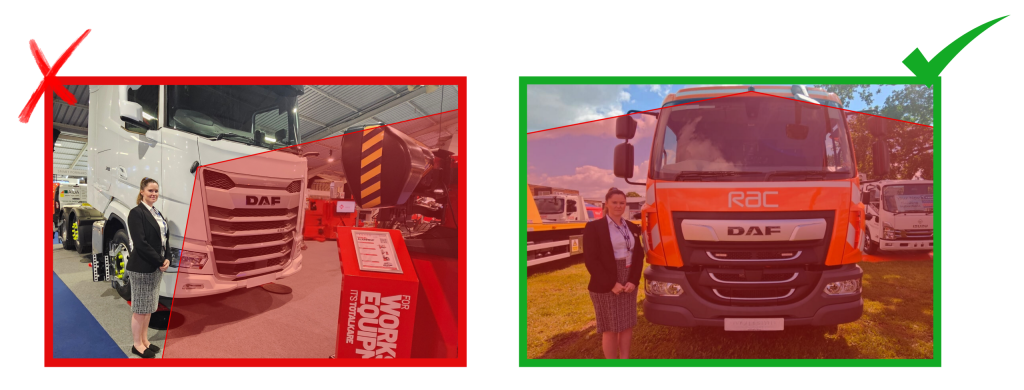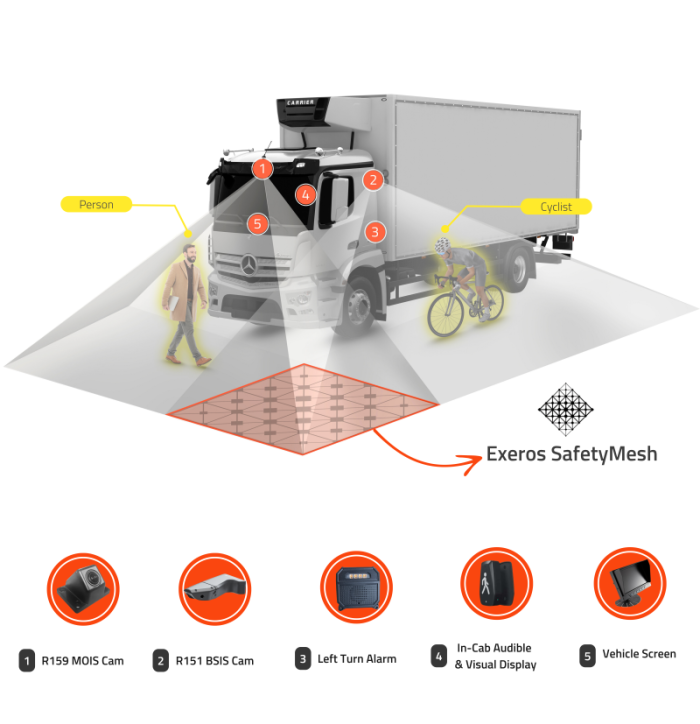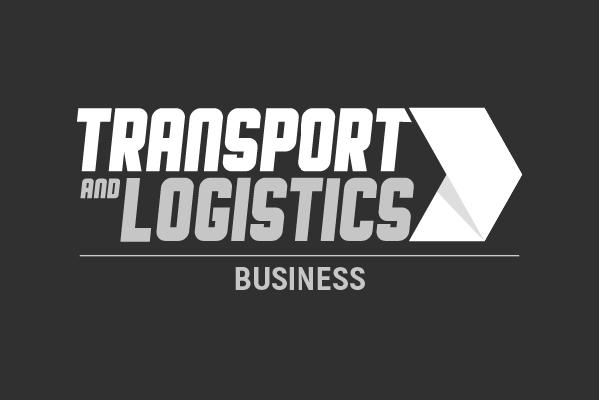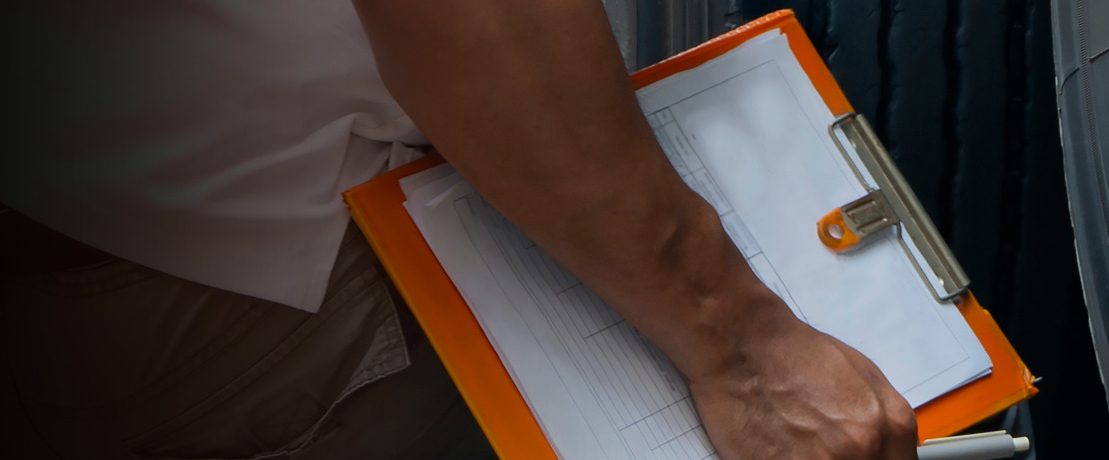Following TfL’s major DVS update on May 13th, 2024, hauliers are being urged to inspect their fleet’s Direct Vision Standards (DVS) systems as evidence shows that some devices, which claim to meet London’s DVS specifications, are actually non-compliant, putting pedestrians and Vulnerable Road Users (VRUs), as well as fleet operators, at risk in the capital1.
Fleet operators face primary liability if their DVS systems, installed by third parties, do not meet the standards and a collision occurs with a VRU. Exeros are experts in ensuring compliance and can assist you.
Important clarification: TfL has clarified that systems operating on close-proximity detection do not comply. This update in the PSS BSIS Specifications on May 13, 20242, resolves previously ambiguous AI detection and algorithm interpretations. The information signal is required, but collision warnings should only be issued if the VRU or vehicle trajectory changes towards the other and an imminent collision risk arises. Repeated audible alarms when a VRU travels parallel or near to the vehicle are unacceptable, according to TfL’s new specifications.
Compliance with DVS regulations ensures that camera systems are correctly positioned and calibrated, providing accurate and reliable audio and visual information to drivers.
AI trajectory prediction is the ability for the camera to predict the forward path of a cyclist or VRU in relation to the vehicle. The system must accurately be trained using AI machine learning to recognise these scenarios and provide instantaneous feedback to the driver.
TfL’s original specifications have been largely misinterpreted by many DVS system suppliers who have only trained their systems to work off VRU proximity. These non-compliant systems are now installed to thousands of HGVs in London and there is significant risk to those fleet operators who have installed these systems believing them to be compliant when unfortunately, they are not.
Exeros Technologies has developed highly trainable DVS systems whereby training new algorithms to comply with future TfL specification changes is relatively straightforward. Our systems already incorporate VRU trajectory prediction making them fully compliant and future-proofed to give fleet’s confidence for current and DVS compliance.
Is your DVS system compliant?
The Moving Off Identification System (MOIS) for fleet vehicles, designed to meet the October 2024 DVS regulations, requires a forward detection that covers the width of the vehicle plus 50m on each side.
The system should provide an early warning light when a vehicle is stationery and a VRU enters that detection zone in front of the vehicle. If the vehicle is about to move away, then the system will immediately turn to a red alert, giving the driver audible and visual alarms to the risk in front.
MOIS is designed to overcome the forward blind spot areas of high cab vehicles which can be illustrated below.

BSIS
A Blind Spot Information System (BSIS) is supposed to alert the driver of an imminent collision risk to the nearside of the vehicle.
Systems are to detect VRUs adjacent to the vehicle that are shortly due to collide with the vehicle or vice versa. The systems need to predict travel paths of both the vehicle and the VRU and only alert if collision is imminent. Based on the Loughborough University report3 which formed the basis of TfL’s DVS initiative, systems should give drivers 1.7 seconds early warning of a potential collision so the driver can react and prevent the accident altogether.
The systems should not alert if a VRU is travelling parallel to the vehicle as long as no collision risk is present.
Naturally, Exeros has challenged this with TfL, as ultra-close proximity of a VRU will give the driver less reaction time if trajectory changes and therefore, in our opinion, early warning is needed. We have future-proofed our systems for any updates to the specifications that may take place later which gives our customers confidence when choosing Exeros.
With our AI DVS systems, there are a range of configurations available to customers and we will be happy to talk you through these advanced options that enable you to comply but also significantly surpass the safety standards set by TfL.
Additional Features
An essential feature of the Progressive Safe System (PSS) is its ability to alert drivers when the system is not functioning correctly. If the camera is obstructed or fails, the system must notify the driver of the malfunction. Ensuring that drivers receive alerts when the system is compromised. Our systems alert the driver if the camera is malfunctioning or if the lens is dirty.
Jay Biring, CEO at Exeros Technologies said “While many operators provide Progressive Safe Systems (PSS) that meet Transport for London’s (TfL) standards, some offer “out of the box” solutions that may fall short. This raises concerns that fleet managers might install equipment that is either unfit for purpose or improperly fitted by unqualified technicians. Such inadequacies can compromise vehicle safety, putting cyclists and pedestrians at greater risk—the very individuals these systems aim to protect. Ensuring proper installation by skilled technicians and a system that fully complies is crucial for maintaining the safety and effectiveness of PSS systems.
Failure to meet these specifications exposes operators to significant liability issues in the event of an incident. Non-compliance could lead to severe penalties, increased insurance premiums, and potential legal actions, jeopardising reputation. Ensuring your fleet meets DVS standards is a proactive step towards safeguarding your business and promoting road safety.”
The importance of due diligence
Installation should be performed by qualified professionals who understand the specific requirements of DVS and can ensure that all components are correctly positioned and calibrated.
Regular maintenance is equally important. Over time, DVS systems can experience wear and tear or become misaligned, which can compromise their effectiveness.
How Exeros can help: Ensuring 100% compliance with 2024 DVS regulations using AI technology

Our AI technology guarantees full compliance with the 2024 Direct Vision Standard (DVS) regulations. We meet all the Progressive Safe System (PSS) requirements as follows:
- Front Blind Spot: A Moving Off Information System (MOIS) is installed at the front, providing active alerts to the driver. Systems complying with BSIS UN 159 meet these specifications.
- Nearside Blind Spot #1: A Blind Spot Information System (BSIS) is equipped with active alerts for the driver. Systems complying with BSIS UN 151 meet these requirements.
- Nearside Blind Spot #2: A nearside Camera Monitoring System or Class V and VI mirrors are used to eliminate all remaining nearside blind spots.
- Audible Alerts: The vehicle is equipped with audible warnings to alert cyclists and pedestrians when the vehicle is turning left.
- External Blind Spot Warning Stickers: Applied to the vehicle to enhance safety awareness4.
By implementing these measures, we ensure your fleet adheres to the highest safety standards set by TfL.
The DVS deadline is approaching – ensure compliance for your fleet
As the Direct Vision Standard (DVS) deadline rapidly approaches, it is crucial for all fleet operators with vehicles over 12 tonnes to prioritise compliance with these regulations. The importance of DVS compliance cannot be overstated. It plays a vital role in enhancing road safety by reducing blind spots and ensuring that drivers have a clear view of vulnerable road users, including pedestrians and cyclists.
Choosing Exeros Technologies ensures that your fleet will meet the stringent DVS requirements. We specialise in exceptional installation and advanced safety systems that comply with the latest standards, providing consultation and comprehensive solutions to eliminate blind spots and enhance driver.
Transport & Logistics – Driving The Industry Forward












